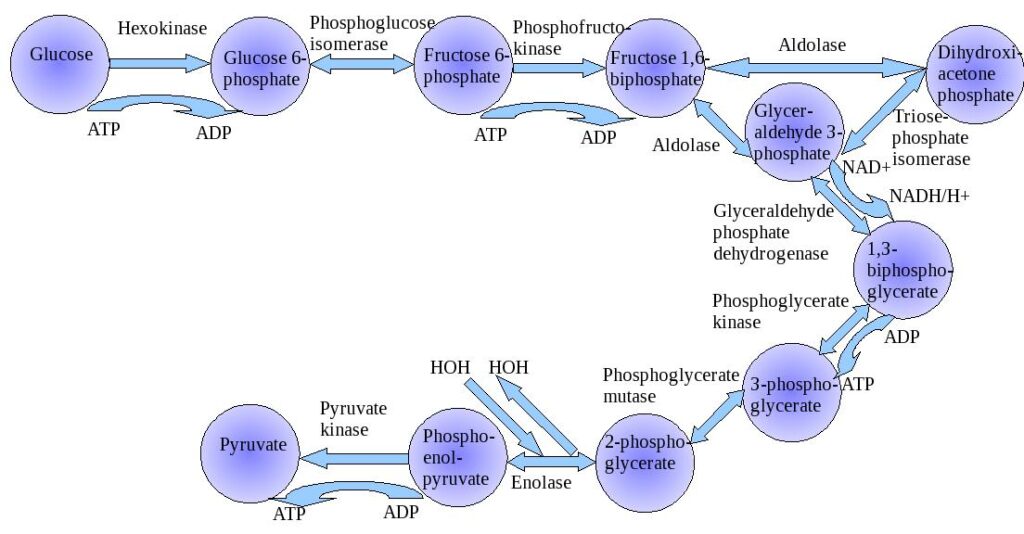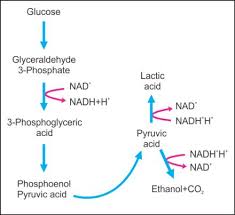It is common step of both types of respiration which takes place in cytoplasm. Glycolysis (Greek glycon- for sugar and lysis- for splitting)means up of sugar. This scheme of glycolysis was given by Gustav Embden, Otto Meyerhof, and J. Parnas, and often referred to as the EMP Pathway.
In plants, the glucose is derived from sucrose, which is end product of photosynthesis, or from storage carbohydrates. Sucrose is converted into glucose and fructose by the enzyme, invertase, and these two monosaccharides readily enter the glycolytic pathway. In animals, starch is digested into glucose and that is used in the glycolysis.
The first half of this pathway activates glucose (glucose activation phase). The second half extractionthe energy (energy extraction phase).
Product of glycolysis-
(1) 2 molecules of pyruvic acid
(2) Net gain to 2ATP molecules

Pfeffer- Kostychev scheme represents interrelationship between aerobic and anaerobic respiration.
Carbohydrates
|
Glucose
| This is common to both aerobic
and anaerobic respiration
Glycolysis or EMP pathway |
Pyruvic acid
|
In absence of O2 In absence of O2 In presence of O2
Alcoholic fermentation Lactic acid fermentation Aerobic respiration
(C2H5OH+CO2+ Energy) (C3H6O3 + Energy) (CO2 + H2O + Energy)
Fermentation is a kind of anaerobic respiration, carried out primarily by fungi and bacteria. Although people had been using this process in the preparation of wines since prehistoric times but failed in their attempts to understand the alcoholic fermentation. Gay Lussac was the first to discover fermentation.
- Alcoholic fermentation:-
Pyruvic acid formed at the end of glycolysis is converted to alcohol by using the enzymes, pyruvic acid decarboxylase and alcohol dehydrogenase.
(i) In the first step, pyruvic acid is decarboxylated resulting in the formation of acetaldehyde and CO2
2CH3COCOOH —pyruvic acid decarboxylase– 2CH3 CHO + 2CO2
(Pyruvic acid) Mg++ (Acetaldehyde)
(ii) In second step, acetaldehyde is reduced to alcohol by 2NHDH+ H+
2CH3CHO + 2NADH + 2H+–Alcohol dehydrogenase—2C2H5OH + 2NAD+
(Acetaldehyde) (Ethanol)
Example:- This commonly seen in the yeast and certain bacteria.
Ethyl alcohol does not stay inside micro-organisms but is excreted. Accumulation of alcohol beyond a certain limit can, however, kill the microorganisms. Yeasts poison themselves to death when the concentration of alcohol reaches about 13%. Therefore, maximum concentration of alcohol is beverages that are naturally fermented is 13%. A higher concentration of alcohol is a beverage is achieved.
Pyruvic acid formed at the end of the glycolysis is reduced to lactic acid by homofermentative lactic acid bacteria (Lactobacillus lacti)
CH3COCOOH— Lactic acid dehydrogenase—CH3CHOHCOOH
(Pyruvic acid) FMN, Zn+2 (Lactic acid)
During vigorous exercise, when oxygen is inadequate for cellular respiration pyruvic acid is reduced to lactic acid by using the enzyme lactate dehydrogenase.
.

Special features of alcohol and lactic acid fermentation:-
(i) In both lactic acid and alcohol fermentation not much energy is released ; less than seven percent of the energy in glucose is released and not all of it is trapped as high energy bonds of ATP.
(ii) Both the processes are hazardous – either acid or alcohol is produced.
(iii) Net gain in both the types of fermentation is 2ATP.
(iv) Alcohol fermentation results in the release of CO2 along with ethanol while lactic fermentation releases lactic acid only.
(v) The reducing agent is NADH + H+ which is reoxidised to NAD+ in both the processes.

Glycolysis is a metabolic pathway that converts glucose into pyruvate, producing ATP and NADH in the process. It occurs in the cytoplasm of cells and is the first step in cellular respiration.
Glycolysis consists of 10 steps, divided into two phases:
- Energy Investment Phase (Steps 1-5):
- Glucose is phosphorylated to glucose-6-phosphate (G6P).
- G6P is isomerized to fructose-6-phosphate (F6P).
- F6P is phosphorylated to fructose-1,6-bisphosphate (F1,6BP).
- F1,6BP is split into two three-carbon molecules, dihydroxyacetone phosphate (DHAP) and glyceraldehyde-3-phosphate (G3P).
- DHAP is converted to G3P.
- Energy Payoff Phase (Steps 6-10): 6. G3P is oxidized to 1,3-bisphosphoglycerate (1,3BPG), producing NADH. 7. 1,3BPG is converted to 3-phosphoglycerate (3PG), generating ATP. 8. 3PG is converted to 2-phosphoglycerate (2PG). 9. 2PG is dehydrated to phosphoenolpyruvate (PEP). 10. PEP is converted to pyruvate, producing ATP.
For each molecule of glucose, glycolysis produces:
- 2 molecules of pyruvate
- 2 molecules of ATP (net gain)
- 2 molecules of NADH
Glycolysis is the first stage of cellular respiration and is essential for providing the necessary substrates for the citric acid cycle and oxidative phosphorylation. It can also function anaerobically, allowing cells to generate energy in the absence of oxygen.
Glycolysis is regulated at key enzymatic steps:
- Hexokinase/Glucokinase: Inhibited by its product, glucose-6-phosphate.
- Phosphofructokinase-1 (PFK-1): Activated by AMP and fructose-2,6-bisphosphate; inhibited by ATP and citrate.
- Pyruvate kinase: Activated by fructose-1,6-bisphosphate; inhibited by ATP and alanine.
The fate of pyruvate depends on the presence of oxygen:
- Aerobic conditions: Pyruvate is transported into the mitochondria and converted to acetyl-CoA, which enters the citric acid cycle.
- Anaerobic conditions: Pyruvate undergoes fermentation to lactate (in animals) or ethanol and CO2 (in yeast).
Yes, glycolysis can occur anaerobically. In the absence of oxygen, cells rely on fermentation to regenerate NAD+ from NADH, allowing glycolysis to continue.
Glycolysis is a universal pathway found in almost all living organisms. It provides a quick source of ATP and metabolic intermediates for other pathways, regardless of oxygen availability.
While the fundamental steps of glycolysis are the same in prokaryotes and eukaryotes, the regulatory mechanisms can differ. Additionally, in eukaryotes, glycolysis occurs in the cytoplasm, while subsequent steps of cellular respiration take place in the mitochondria. Prokaryotes carry out the entire process in the cytoplasm or associated with the plasma membrane.
Defects in glycolytic enzymes can lead to various metabolic disorders, such as:
- Pyruvate kinase deficiency: Causes hemolytic anemia.
- Phosphofructokinase deficiency (Tarui disease): Leads to exercise intolerance and muscle pain.